Thailand is located in a subequatorial climate and has a rich flora and fauna. The Land of Smiles is home to about 27 thousand species of plants, some of which are considered national symbols of Thailand, and grow on the streets and in gardens. Local residents, according to tradition, decorate their houses and streets with flowers, so when you get to Thailand, you will be surprised by the amazing aromas hovering in the streets.
Once in Thailand, your attention will definitely be attracted by the flower garlands-amulets with which the country's residents decorate Buddha statues, as well as chandeliers, cars and church altars.
This beautiful and mysterious flower has long been considered the flower of Buddha, and expresses human beliefs about spirituality, happiness, God, inner harmony, health, completeness of existence and even immortality. In Thailand, the lotus is a sacred plant that symbolizes wisdom, nirvana and spiritual knowledge. It is personified with Buddha as an image of purity, because growing out of mud, this flower breaks through the water to appear on the water surface in the form of an ideal inflorescence - like Buddha, who was born in the ordinary world and achieved top level enlightenment.
The lotus is considered one of the eight treasures, or, as they are also called, auspicious signs. The image of a lotus with 12 petals is a symbol of the universe and God, with 9 petals - a symbol of man, with 5 petals - a symbol of the feelings that we experience. 3 lotus petals are a symbol of all worlds and deities, and the symbol of the sun is a lotus with a thousand petals.
Lotus flowers are a mandatory accessory for Buddhist rituals and ceremonies. It usually grows in flowing reservoirs or slow-flowing rivers, as well as in wetlands. It blooms at sunrise and closes in the evening. Droplets of water roll down the petals of a flower, like mercury, because its petals are covered with a special waxy coating, which contributes to the flower’s ability to self-cleanse.
The lotus blooms for only a few days, and some of the petals fall off on the first day, and the rest gather again into a bud. Until the third day, the petals completely fall off, the peduncle dries up, and a fruit begins to form, the seeds from which fall to the bottom, after which new plants appear.
This amazing flower is used in incense, aromatherapy and cooking. It is believed that incense that was prepared with the addition of lotus promotes relaxation and protects against the evil eye.
You will encounter these flowers throughout your entire trip to Thailand, where they arrived more than 2.5 thousand years ago from China. Currently, about 1,000 species of orchids are grown in special greenhouses throughout the country, so this flower can be called the calling card of the Land of Smiles. Thais love orchids, so they often decorate restaurants, homes and workplaces with them, and girls like to decorate their hair with orchid hair clips, or simply pin the flower to their clothes. This is very tender plant, which does not tolerate temperature fluctuations well.
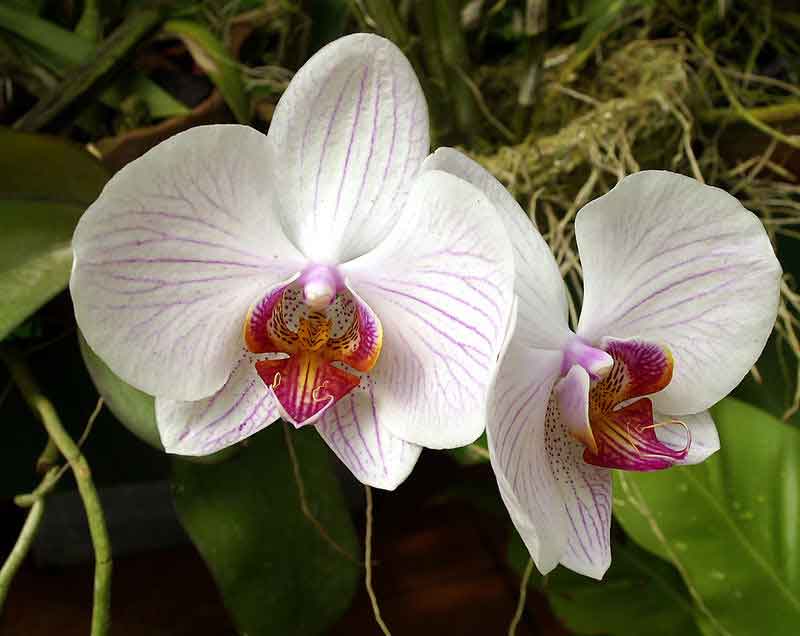
Many people who come to Thailand definitely want to take this beautiful flower, but before you do this, you need to remember a few rules for growing and storing this plant. One of the most important conditions It requires light to grow it, so the room in which you plant the orchid should be very bright, located in the southern or eastern part of the house. One of interesting features is the growing environment of the orchid - after all, many of its tropical species are considered air plants, which grow directly on trees, and if you place them in water, their growth stops. We recommend growing these species in pots with a porous filling such as fir bark, granulated pottery or stones.
Orchids cannot stay in dry soil for a long time, so they need to be constantly watered, because to maintain the life of a flower, 60% humidity is needed, dry air kills flowers. The export of orchids from Thailand is not prohibited, but for transportation you will need to place the flower in a special glass container with a special composition in order to bring this beauty home safely.
Bougainvillea
This is a Brazilian plant with a French name, which it received in honor of the navigator Louis Antoine de Bougainville, during trip around the world which she was discovered by naturalist Carnerson. This flower belongs to the nocturnal family and comes from tropical forests. IN wildlife There are about 14 species of this flower, which are common in the tropical regions of Central and South America– here they grow in the form of small trees or bushes.
It is an evergreen climbing shrub that can reach 5 meters in height, with sharp leaves and a thorny stem. In Thailand, it decorates high fences of houses, gazebos, arched passages in parks and courtyards. The color range is simply amazing - from white and yellowish to brick, purple and lilac shades.
Heliconia
This plant has received many names due to its unique and unusual appearance: Lobster claw, parrot beak, wild banana and false bird of paradise. If you take a closer look, you will agree that its flowers can indeed resemble the outlines of animals. Heliconia belongs to the banana family, and most often grows on hillsides, tropical rainforests and near bodies of water. Residents of Thailand believe that if you wrap a heliconia leaf around your lower back, it can relieve you of stomach pain, and a decoction of young shoots heals wounds after a snake bite.
The total number of flowers in a heliconia inflorescence can reach nine hundred; they bloom for about five months, although there are species that can bloom all year round. Bright bracts reach a length of up to 25 centimeters; they are called bracts; each bract contains from two to twenty flowers. The upper bracts are parallel to the ground, and they contain liquid that is secreted by heliconia. In such mini-pools, the remains of dead flowers decompose, and various aquatic insects and protozoa swim. Bright flowers are red, orange or pink color and have a glossy shine. In Thailand, heliconia most often grows in parks or on tropical islands such as Krabi, Koh Samui, Phuket and Koh Chang.
In Thailand, flowers are presented to spirits and ancestors much more often than to living girls. In any of the temples you can see skillfully woven garlands and whole canvases of fresh flowers. Before entering the temple, you will be offered to buy at least one lotus or jasmine flower to appease the spirits. Mystical creatures play in this country important role, so if you want good luck in matters of love or everyday life, don’t be greedy and buy a flower.
In February, the city of Chiang Mai holds an annual flower festival, which is celebrated for three days. But tickets to Chiang Mai need to be booked in advance. During the festival, you will see flower parades and musical orchestras, accompanied by festively dressed people who are decorated with garlands of flowers. At the end of the holiday, a beauty contest is held at which the Queen is elected.
I bring to your attention a selection of the most common plants in Thailand. Those flowers and trees that can be found not only in the jungle and tropical thickets, but those that grow, as they say, by the road, and catch the eye everywhere: along the beach, at the entrance to a temple, on hotel grounds. Many of the plants found in Thailand can be seen in our flower shops, sold as indoor flowers.
Plumeria The more popular name for this flower is frangipani, named after the Italian perfumer who created an exquisite scent using plumeria flowers. This fragrant, delicate scent is felt immediately as soon as you approach the tree.
The ancient Mayans considered plumeria a symbol of lust and passion, and in modern Thailand the tree is planted near Buddhist temples as a symbol of immortality. Most rich aroma The most delicate plumeria flowers can be caught early in the morning.
Bougainvillea
This plant is one of the most common in Thailand. Climbing vines and spherical compositions of bougainvillea can be seen almost everywhere - the plant is unpretentious and hardy.
Small and neat petals are bright pink, scarlet, yellow, white or purple.
The plant got its name thanks to the expeditions of the French navigator L. Bougainville, who brought 12 species of this climbing, heat-loving shrub from Brazil.
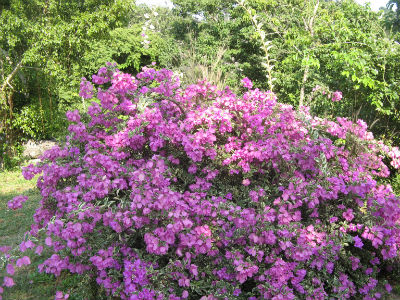
Bougainvillea on the bridge over the lagoon
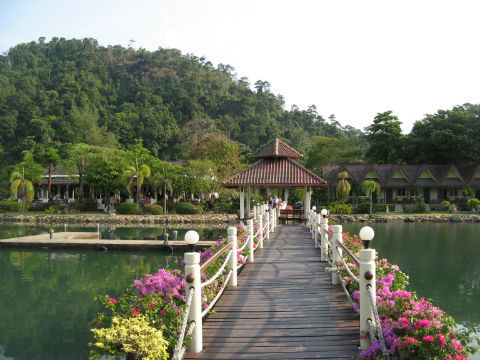
Beautiful orchids
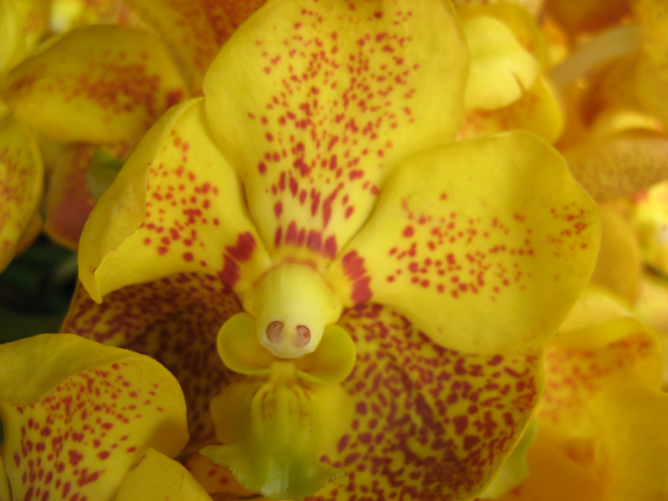

Platycerium, antler or flathorn.
The name of the plant refers to the characteristic shape of the leaves, reminiscent of deer antlers. It lives on the trunks of large trees and can reach up to 1 m in diameter. Grows with orchids and mosses.
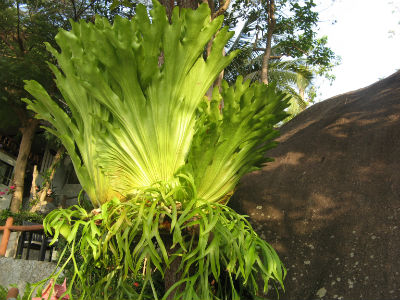
Heliconia Thanks to its unusual, extraordinary appearance, heliconia has received many interesting nicknames: wild banana, lobster claw, false bird of paradise, parrot beak. If you look closely, the flowers actually resemble the shapes of animals. The name of the plant was given by Carl Linnaeus in honor of Mount Helicon in southern Greece, where, according to myth, Apollo and the Nine Muses lived, and therefore the name “Heliconia” hints at the beauty and durability of this flower.
Heliconia flowers are a major source of nectar for tropical birds.
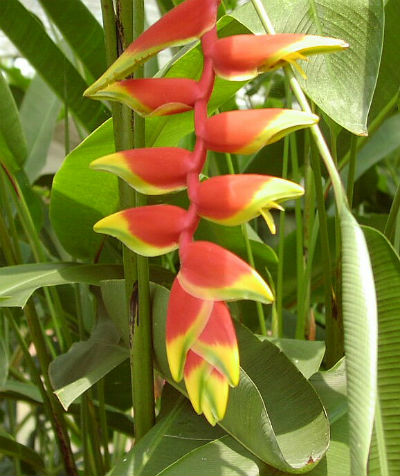
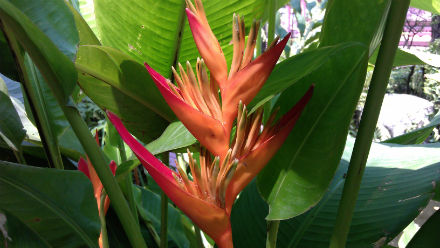
Ginger.Yes, yes, this is the same ginger that is used in cooking and how medicinal plant. Found everywhere in Thailand.
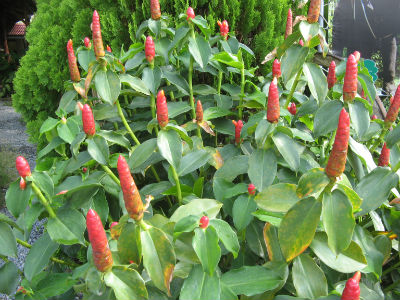
Etlingera, stone rose . Another plant from the ginger family.
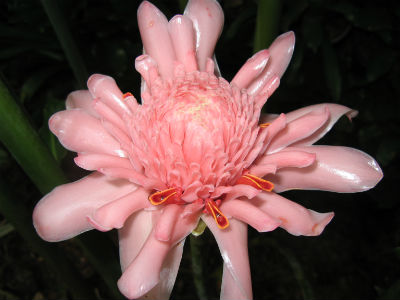
Alpinia purpurea, Red Ginger. Also from the ginger family.
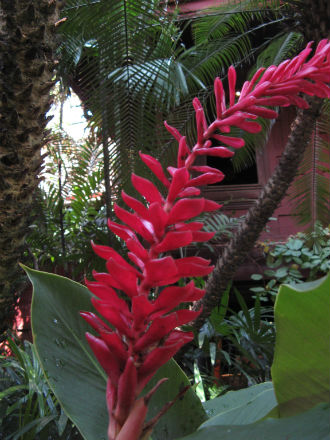
Cassia tubularis, golden tree, Golden Rain.
Tree up to 10-20 m high. Found everywhere. During flowering, it is strewn with racemose bright yellow inflorescences. It received the name “tubular” due to the fruits, which are beans, pods 50-70 cm long. A decoction of beans is used as a mild laxative.
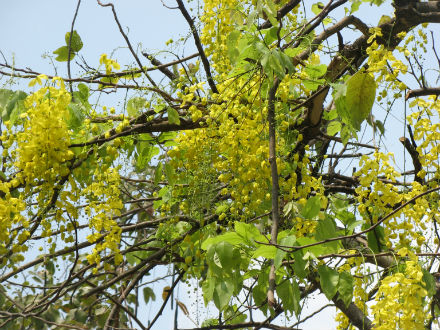
Cassia Glauka . A profusely flowering shrub that grows everywhere.
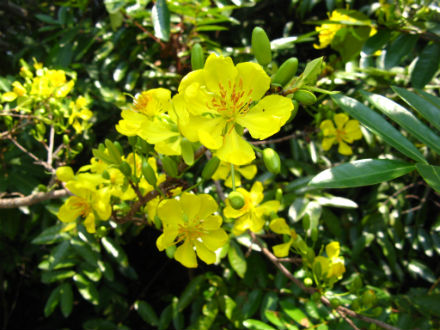
Cassia Baker - a low tree up to 12 m, with a wide, spreading crown. The main flowering period is from February to April. At this time, the plant is almost completely covered with delicate flowers, from pale pink to almost white. For this feature it is often called “Pink Rain” or “Pink Shower”. The spectacle is no less fascinating than the cherry blossoms in Japan.
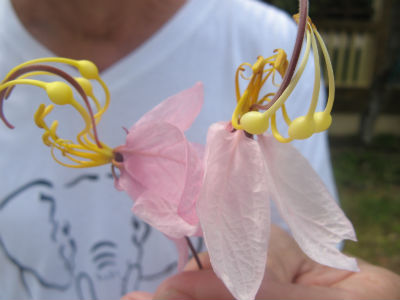
Allamanda "Golden Butterfly"
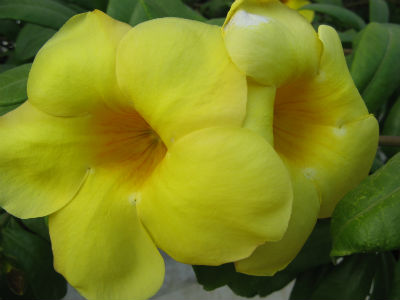
Allamanda peach
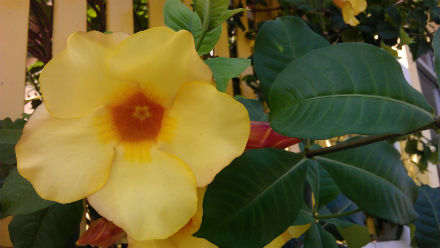
Duranta, popularly known as "pigeon berry".Low shrub with blue flowers and leaves similar to the leaves of our birch, which is why when growing durantas as indoor flower it is called "indoor birch".
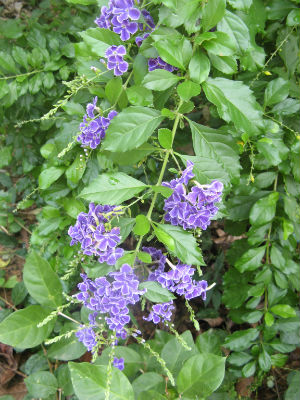
Ravenala Madagascar. Fan tree, traveler tree, well tree.
The plant received the name “Traveler’s Tree” due to the fact that the stem shells contain water, which can be used in emergency situations. Translated from Malgash, the name of this plant means “leaf of the forest.” The leaf length reaches 3 m, width from 25 to 50 cm.
The leaves are used as roofing material, leaf veins as building material. The starchy seeds and young leaves are edible. The seeds are ground and made into flour. The halved and hollowed-out tree trunk is traditionally used in Madagascar for roofing.
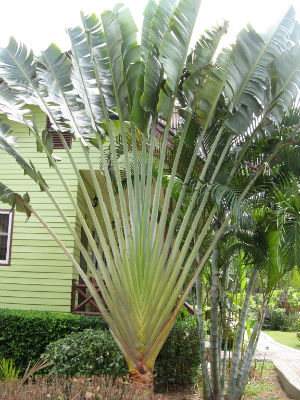
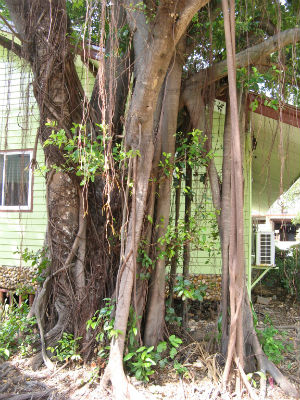
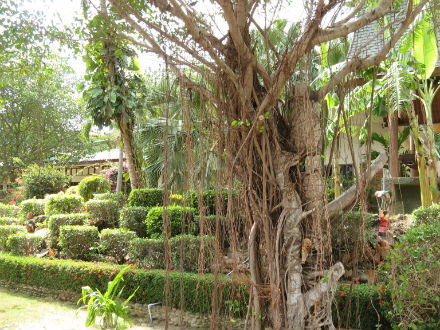
Hymenocallis. Other names for Hymenocallis: angel's trumpets, bride's basket, Peruvian narcissus, ismene.
Hymenocallis is found everywhere in Thailand, in the flower beds of almost every hotel. The shape of the flower resembles a spider.
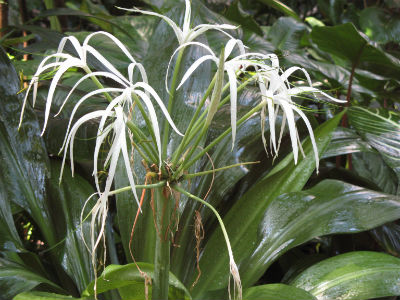
Tillandsia usneiformes
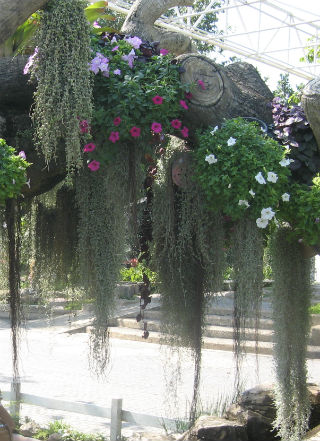
Curupita Guiana (Sala tree)
This flower is famous for blooming on the tree that grows at Wat Arun.
By the way, this is the second most sacred tree for all Buddhists. Along with the bodhi tree, which can be found on the grounds of almost every temple or monastery and under which the Buddha gained enlightenment, the sal tree is the tree under which the Buddha was born and cremated.
In the North of Thailand it is more common (the climate for it is better there), and many Thais treat the amazingly beautiful and fragrant flowers of this tree, somewhat reminiscent of magnolias, with awe and reverence.
![]()
Casuarina horsetail, or the so-called “Thai Christmas tree”.Although this is not a flower, it is impossible not to mention the casuarina. It is found everywhere along the sea coast. Thanks to its leaves, it reminds us of our Christmas tree or pine tree. A large tree with soft, horsetail-like leaves, it can reach a height of up to 35 m.
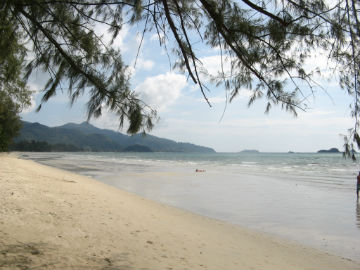
Raithia religious - is a symbol of the spirituality and holiness of Thailand. Raitiya is the sacred flower of all Buddhists and is very popular in Thailand. During flowering, raithia is strewn with flowers hanging from flexible branches that have a strong aroma.
Raitia can be found near pagodas and temples, in parks and on the streets. Especially a lot of religious raithia grows near Buddhist temples; its aroma helps to enter a state of meditation and trance.
Another name for Raithia is “water jasmine”, this name is due to its intense, fruity scent, more delicate than the smell of jasmine, cat It intensifies at night. After flowering, fruits are formed - long green pods.
Raithia religious

Raitia antidysentery - winter cherry, snowflake, milky way.The bark of this tree is used in folk medicine for dysentery and for the treatment of fungal diseases.
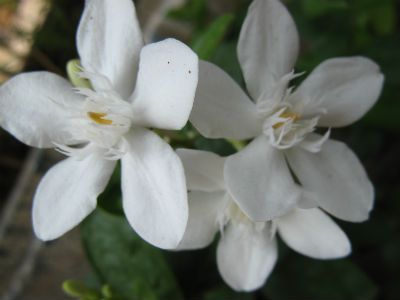
Bauhinya - orchid tree , received its second name for beautiful flowers resembling orchids. Bauhinya leaves are associated with butterflies because... at night they fold along the central vein like the wings of a butterfly. Flowers up to 10 cm in diameter bloom in the morning and fade by midday. After pollination, pods up to 30 cm long are formed.
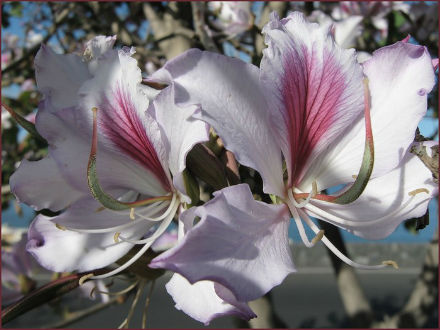
Purple Bauhinha - an evergreen tree with purple-red flowers - the national flower of Hong Kong, depicted on the flag.
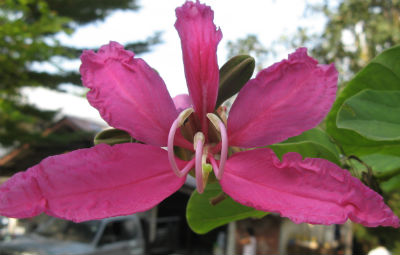
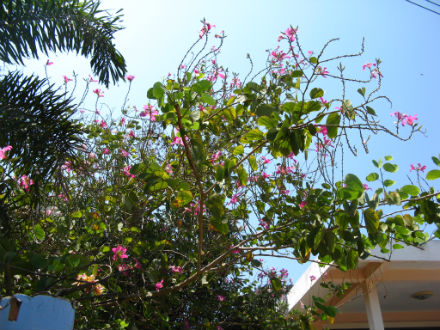
Barringtonia asiatica - queen of the mangrove forests, evergreen tree with very beautiful flowers. Spectacular flowers with many long 10-centimeter stamens, collected in brushes and reminiscent of a pom-pom or neon lamp, open at night, spreading a strong, unforgettable aroma. Barringtonia grows among mangroves, large pyramid-shaped fruits fall into the water and drift along the ocean waves; Fruit germination lasts up to 2 years.
Barringtonia seeds produce poison, which local residents use to immobilize fish in local fisheries. Famous Asian umbrellas are made from paper soaked in Barringtonia juice.
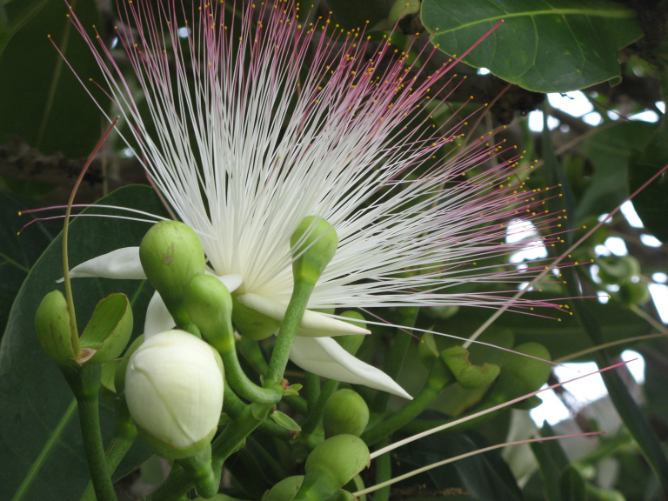
Sacred cochlospermum - an ornamental, temple plant, grows up to 15 m in height. Large, up to 9 cm in diameter, golden-yellow flowers appear after the leaves fall. During flowering, the entire tree is covered with many bright yellow flowers and looks very impressive.
The second name is yellow cotton tree, because. After flowering, fruit boxes with white fluff are formed. The gum used is extracted from tree bark.
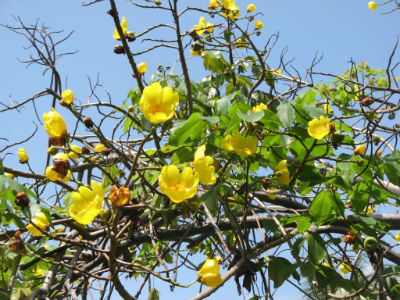
Cochlospermum royal
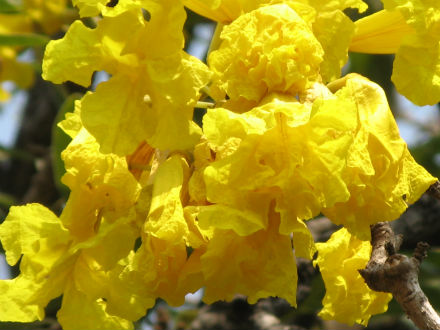
Ohna - unusual plant: The flowers are bright yellow, and the fruits are like bird cherry berries, first red, then turning black, surrounded by a red calyx. For its unusual fruits and their resemblance to the face of a mouse, ohna received its second name - the Mickey Mouse tree.
![]()
Peltoforum- one of the most beautiful trees in the world, a luxurious tree with leaves like mimosa. Bright yellow flowers are collected in inflorescences reminiscent of chestnut flowers.
The second name is Yellow Flame, Caesalpinia Rusty. A yellow dye is made from the bark of this tree.
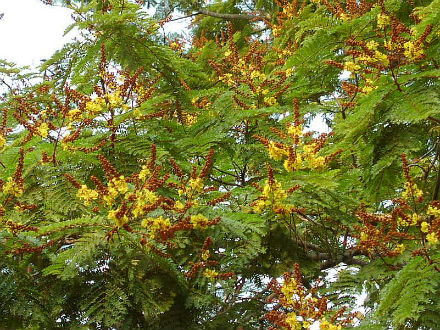
Caesalpinia the Beautiful - or Red Bird of Paradise, Peacock Flower, Parrot Bush - a beautiful and elegant plant with mimosa-like leaves and bright red ruffled flowers with a yellow border around the edge of the petal and long stamens.
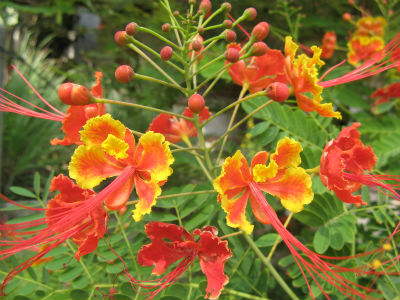
Beaumontia grandiflora (large-flowered) - "Easter lilies", evergreen vine, large leaves can reach 9 cm in length. Huge fragrant snow-white flowers resemble lilies.
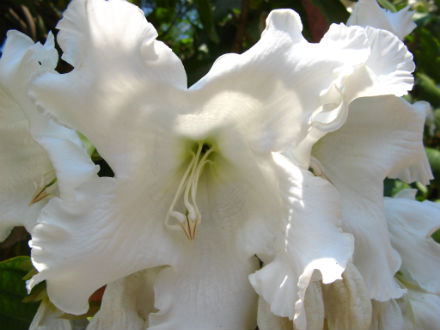
Adenium - "Desert Rose". The plant has gained popularity due to its bright scarlet flowers. When cut, adenium releases poisonous juice.
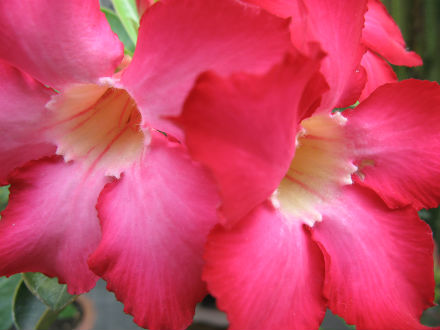
Butea single-seeded, or Butea magnificent, or Forest flame, Broadsword, Parrot tree. Tree up to 15 m high. During flowering, the cluster of flowers resembles a flame. Butea is used as fuel and for medicinal purposes. Rubber is made from resin, tannin is made from wood.
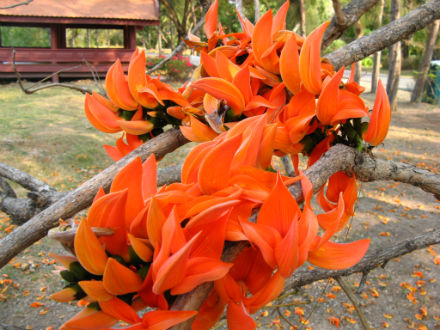
Brownea Ariza, "Venezuelan Rose" .A low tree up to 10 m tall, inflorescences about 12-16 cm in diameter. The leaves resemble the leaves of our mountain ash.
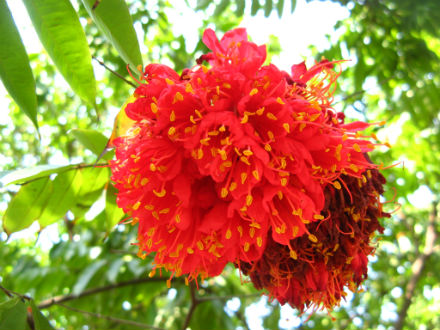
Thunbergia erecta. A shrub up to 1.8 m tall, from which hedges are formed by pruning.
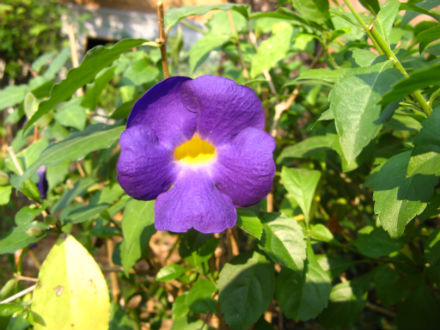
Thunbergia grandiflora
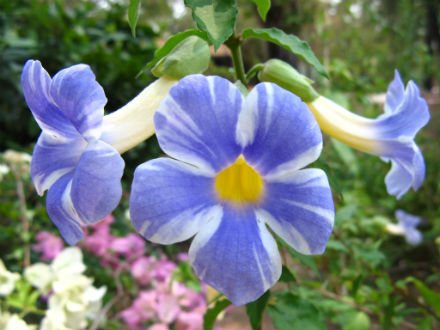
Combretum
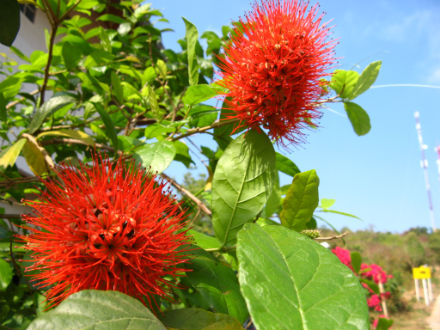

Mussenda Philippine - evergreen shrub, a relative of coffee. Flowers, or rather bracts, reminiscent of velvet in texture, are collected in inflorescences 10-20 cm long, and can be white, yellow, or red.
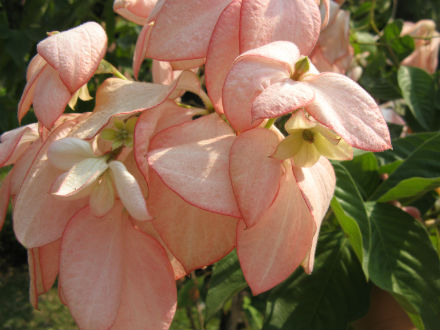
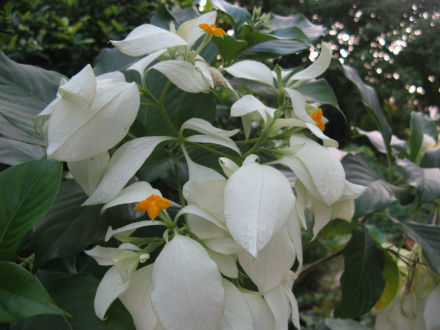
Gardenia Kula, Golden Gardenia. A tree (shrub) with a magnificent scent, similar to that of jasmine. Some flowers are yellow, others are orange. The genus Gardenia is named after Alexander Garden, an American naturalist and physician.
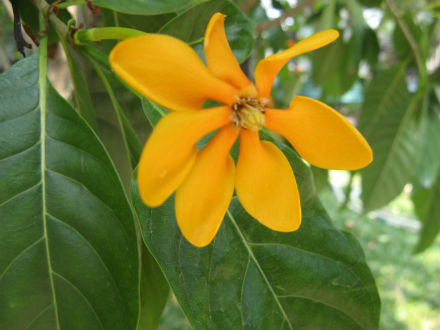
Gardenia jasminoides.
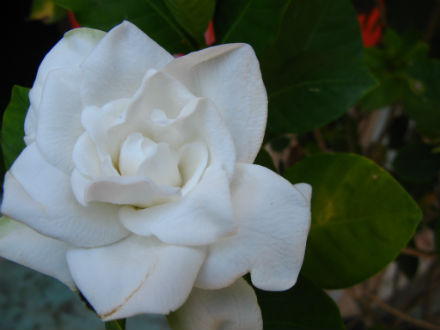
Ixora.Shrub with dense leathery leaves. The inflorescences are umbrella-shaped and spherical in a wide variety of colors: yellow, orange, red.
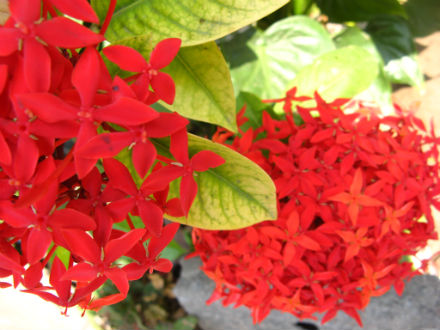
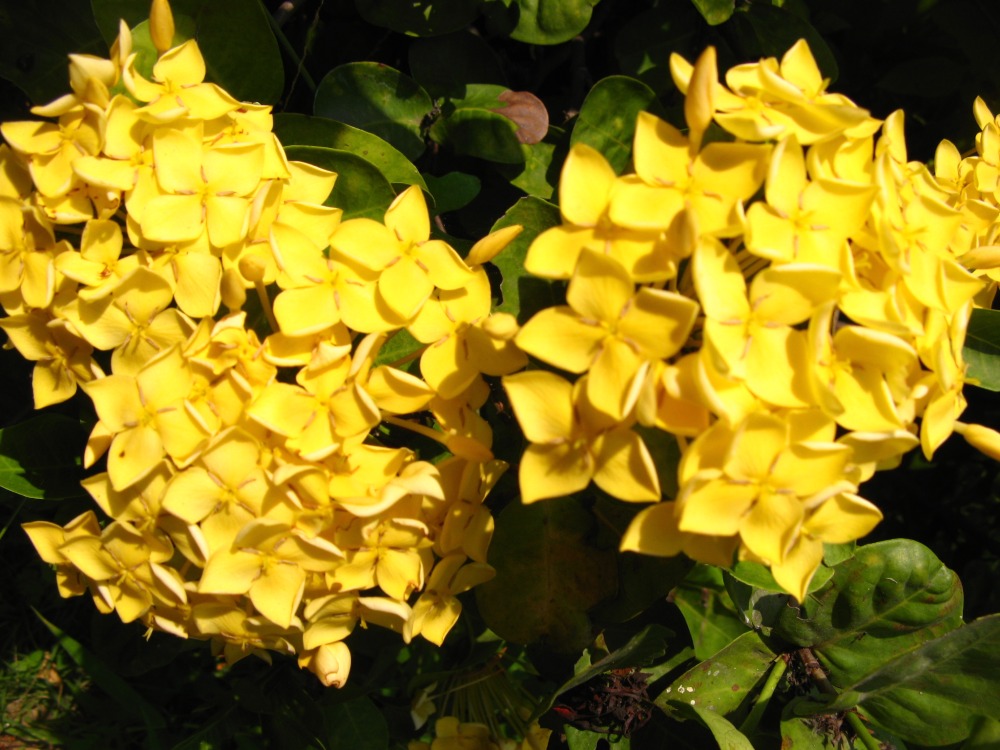
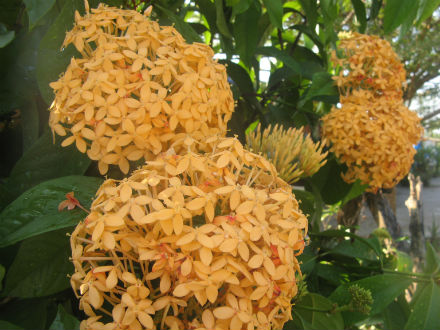
Argyrea branched, small Hawaiian tree rose . Liana, grows up to 9 m in height. The flowers are large lilac bells. Argyrea seeds contain a number of substances included in smoking mixtures, therefore argyrea seeds are prohibited in the Russian Federation. Argyrea roots are used in Ayurvedic medicine.
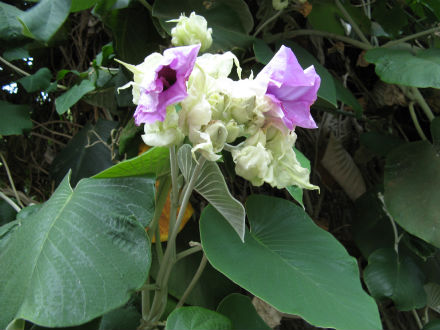
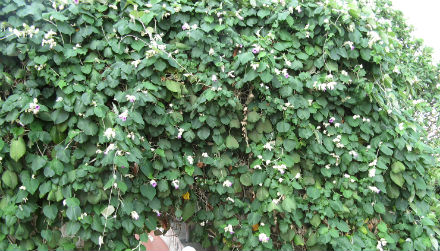
Callistemon willifolia, or beautiful stamen, or red stamen . An evergreen shrub. The inflorescences resemble bottle brushes in appearance.
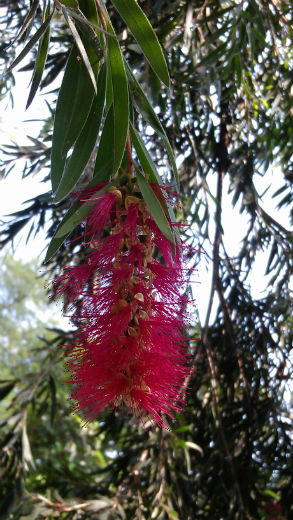
Indian Quisqualis . An evergreen vine up to 6 m in height, it can grow as a shrub. The flowers change color from white to red and exude a rich fruity aroma. Used in folk medicine.
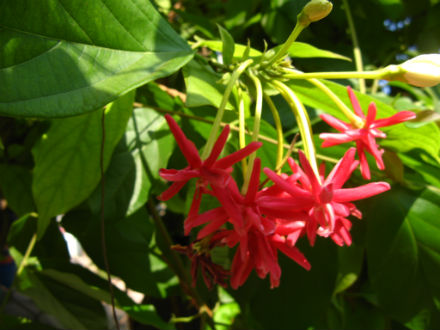
Lagerstroemia beautiful, Banaba, Bungur.
Shrub, less often tree, flowers of various shades from blue, purple to red and white. The wood is used for making bridges, furniture and sleepers.
From Lagerstroemia beautiful, banaba is isolated - a herbal medicine for normalizing blood sugar and insulin levels.
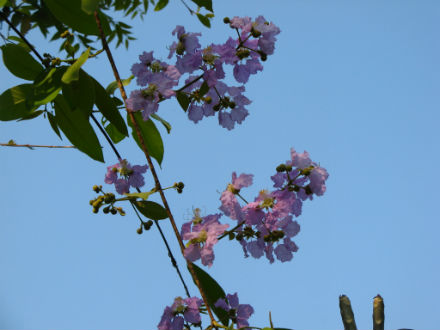
Pseuderanthemum .Ornamental plant up to 1 m high, valued for its colorful foliage and attractive inflorescences.
Pseuderanthemum reticulate.
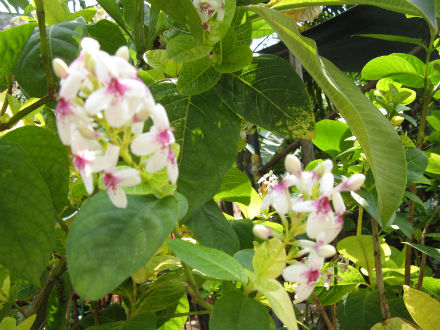
Pseuderanthemum dark purple .
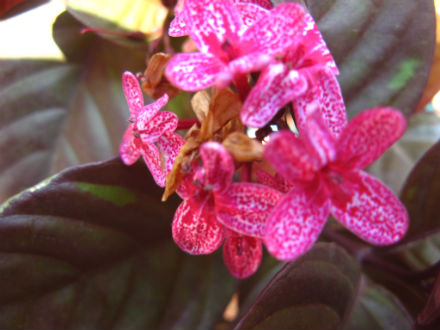
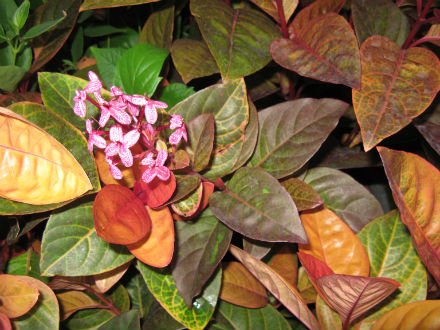
Svinchatka, or Plumbago, Svintsovka, Svintsovitsa .The name comes from Latin name Plumbum lead, because Plumbago was previously thought to be an antidote for lead poisoning.
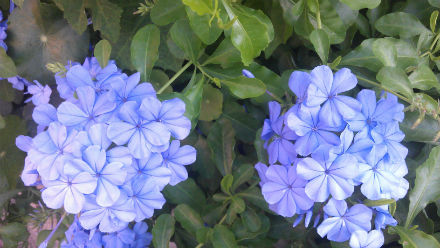
Tekoma erecta, Golden bell, Yellow tulip bush, Yellow elderberry, Yellow bignonia, Esperanza.
Tekoma was chosen as the national flower of the US Virgin Islands, and was also recognized as the national flower of the Bahamas. Tecoma is almost in bloom whole year dazzling yellow funnel-shaped flowers up to 5 cm long. After flowering, long pods up to 30 cm long are formed.
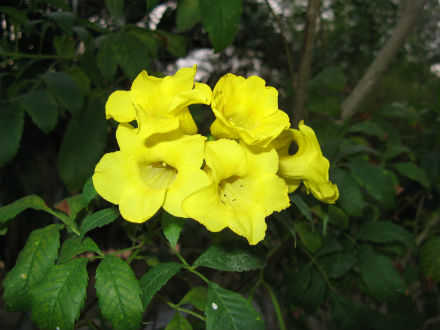
Phyllanthus is beautiful .
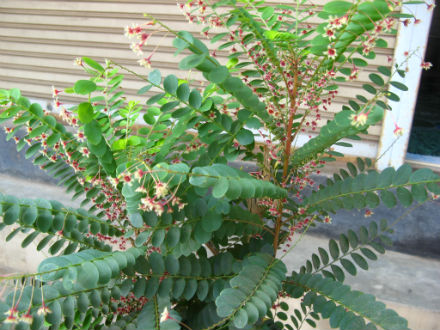
Euphorbia Mila, Euphorbia Mila, Beautiful Euphorbia, "crown of thorns" . The name is given by the name of Baron Mil, who brought this plant to France. It is believed that it was the beautiful Euphorbia that served as the crown of thorns for Jesus Christ. The stem is covered with sharp thorns.
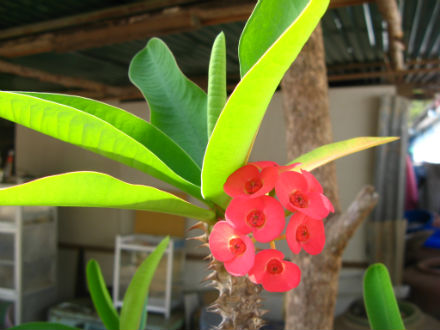
Hibiscus, known to us as indoor plant- Chinese rose. The hibiscus drink is made from hibiscus flowers.
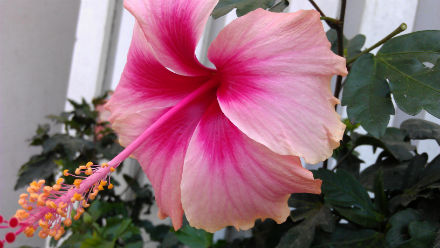
Terry hibiscus James Henry.
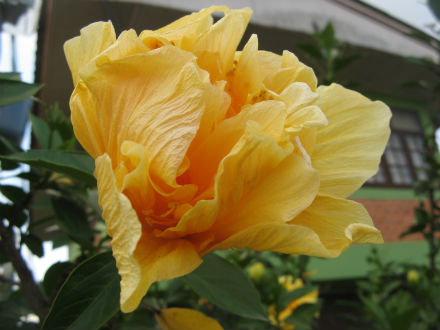
Hibiscus El Capitolio, Dawn with Tequila.
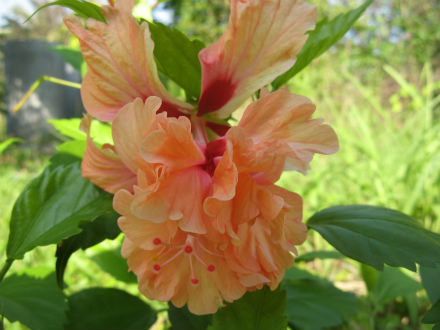
Hibiscus Sabdariffa, Hibiscus, Sudanese Rose. It is from this variety of hibiscus that the famous hibiscus tea, “the drink of the pharaohs,” is obtained. The flowers are pink, the fruits are in the form of bright red fleshy “buds”. The dried fruits are brewed as tea, resulting in a ruby-red drink with a pleasant taste and aroma.
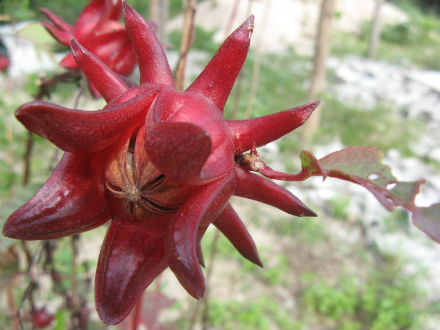
Hibiscus linden tricolor.
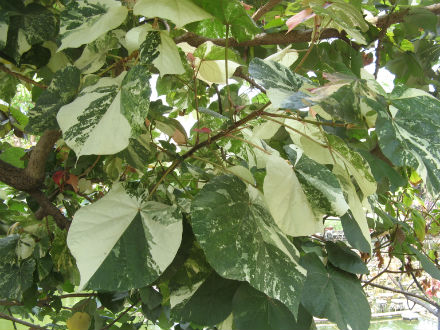
Antigonon is thin, “liana of love.” An evergreen, profusely flowering vine with soft pink flowers collected in clusters decorates all fences and buildings. It grows everywhere.
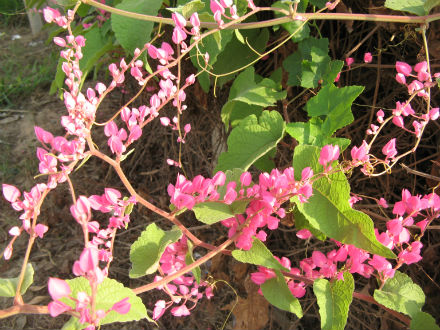
Antigonon Alba
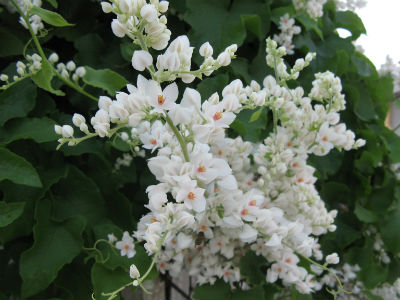
Leukophyllum fruticosa. Evergreen drought-resistant shrub with silvery pubescent leaves and pink flowers.
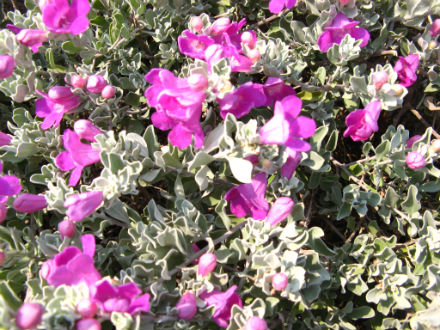
Leukophyllum and Puya Raymonda.
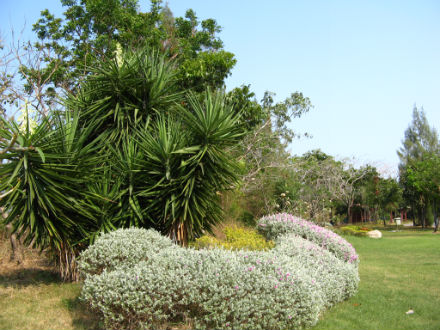
Puya Raymonda, is one of the largest flowers on Earth.
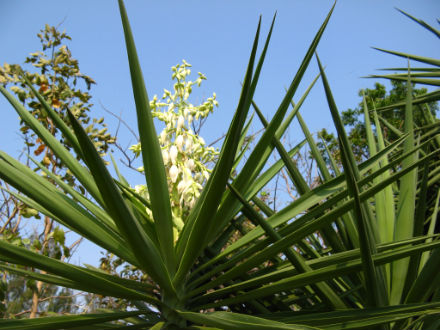
Victoria amazonica, Victoria regia, "bird frying pan" . Named in honor of the English Queen Victoria, it is the largest water lily in the world. It is listed in the Guinness Book of Records as the largest flower plant on Earth.
The plant is notable for its huge, saucer-shaped leaves floating on the surface of the water. The diameter of the sheet can exceed 2m and support a person weighing up to 50 kg!
Beautiful pale pink flowers appear once a year and only at night; early in the morning the petals close and bloom for 2-3 days.
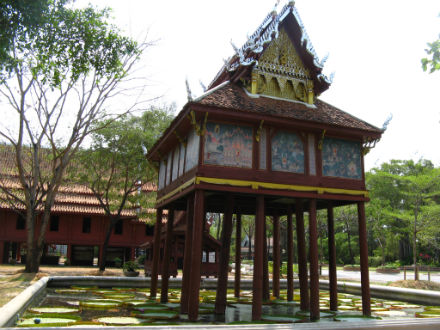
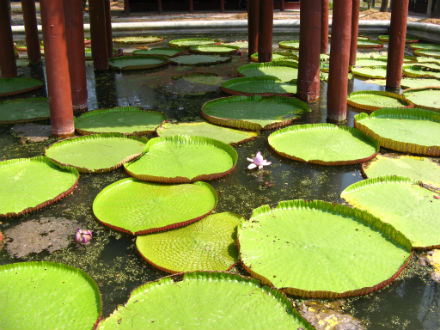
Cerberus is overpowered , suicide tree.
Named after the dog Cerberus, guardian of the kingdom of the dead from Greek mythology due to its toxicity. The tree is so poisonous that even smoke after lighting a fire from Cerberus wood causes severe poisoning. All parts of the tree are poisonous, including the fruit, which resembles green mangoes. Cerbera resembles plumeria, but its leaves are smaller and the flowers are not as beautiful as plumeria.
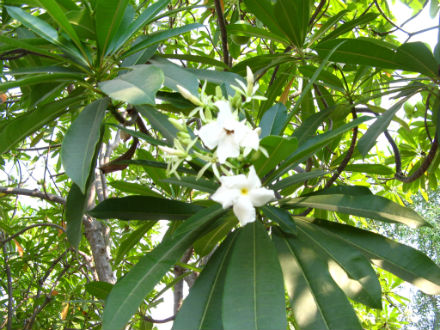
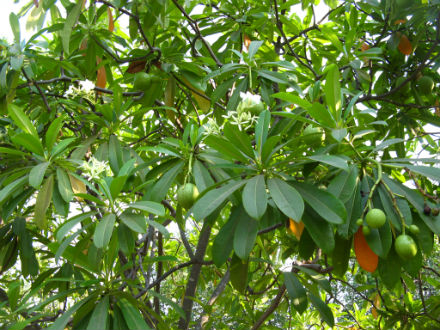
Kapok or white cotton tree - Ceiba pentastamen . The fruits are in the form of large cucumbers, and when they ripen, cotton wool is formed, which local residents can use to stuff pillows.
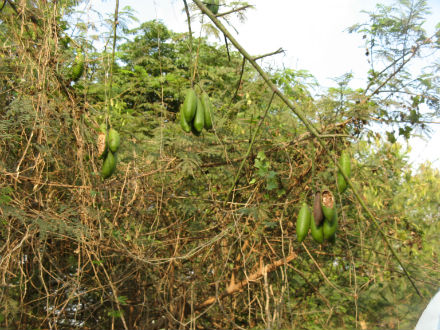
Cordia sestena.

Calotropis gigantea. Valued for its persistent, long-lasting flowers. In Thailand they decorate houses.
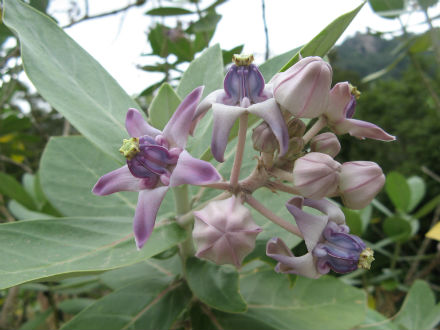
Strophanthus gratus, climbing oleander. One of the most beautiful views strophanthus. It smells very nice, the smell is similar to the smell of a rose. All parts of strophanthus are highly toxic, the pods and seeds are especially poisonous.
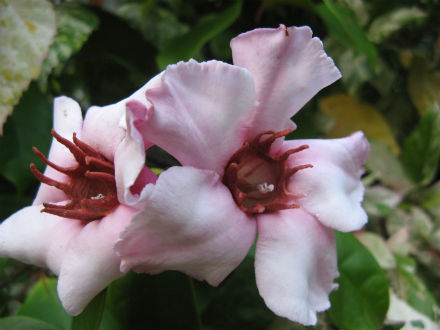
Tevetia (tevetia) oleandrofolia, yellow oleander. It has narrow leaves similar to oleander leaves. The flowers are yellow or delicate apricot color. All parts of the plant are poisonous, even the smell of smoke from burning Tevetia!
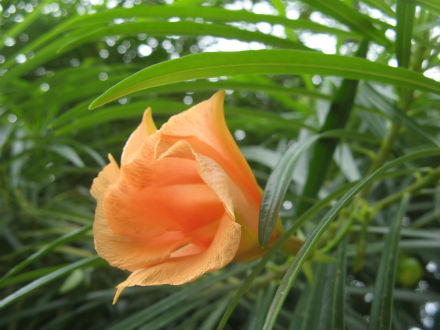
Clitoria trifoliate, butterfly pea, blue pea, pigeon wings, shame flower, anchan. It is an evergreen herbaceous vine. Widely used in scientific and traditional medicine, as well as food coloring. In Thailand, the famous blue tea is brewed from the petals of the clitoris, known for its many healing properties.
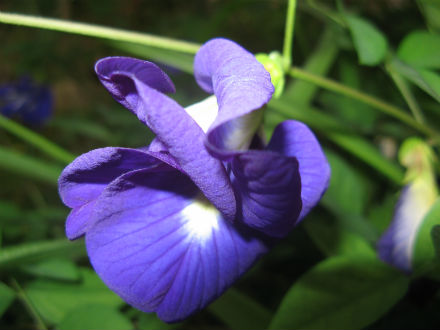
Sesbania Grandiflora, Hummingbird Tree, Butterfly Tree. Huge flowers up to 10 cm in size are collected in brushes. The fruits are smooth pods ranging in size from 20 to 60 cm. Delicate leaves, flowers and unripe fruits are used in cooking.
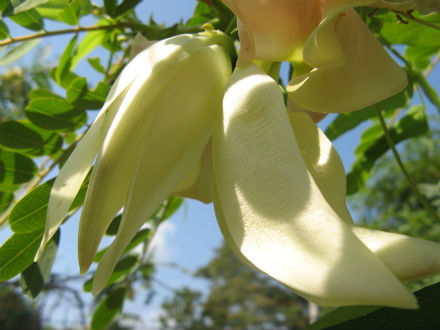
Tabebuia. One of the most beautiful trees peace. Height from 5 to 50 m. Flowers are white, yellow, lilac and red.
What Thailand catches the eye of unprepared tourists is the abundance of flowers. We are accustomed to the fact that even in the most “colorful” August, our streets are still quite ascetic, and therefore the iridescence of Thailand immediately catches the eye. Multi-colored buildings, plants of completely unimaginable colors, residents dressed in all shades of the rainbow - this is the norm for Thailand. And not just for beauty - the variety of flowers in the Land of Smiles has its own meaning.
The colorful culture of Thailand
Superstitious Thais give great value everything that surrounds them and what they are wearing. According to beliefs and legends, no less depends on color than on shape - and when, for example, designing a building or choosing a car, color plays no less a role than the actual architecture of the building or characteristics. What can we say about daily life? Thais also dress in accordance with the laws of Buddhist traditions. And they, in turn, claim that each day of the week has its own color, namely:
- Monday's color is yellow;
- Tuesday – pink;
- On Wednesdays it is customary to wear green;
- And on Thursdays - in yellow;
- Friday is full of blue and its shades...
- ...and Saturday is already purple
- Well, the end of the week, Sunday, is highlighted in red.
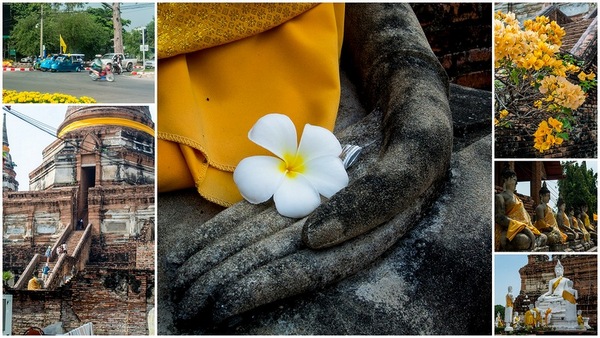
Traditions of Thailand: color comes first!
In Thailand, choosing clothes to match the “color of the day” is a long-standing tradition, which is believed to bring good luck. And although in the 21st century more and more Thais prefer fashion to tradition, even dressing in black (not good color), in the Land of Smiles there are still a lot of believers whose wardrobe is planned according to the days of the week.
Moreover, the days of the week also influence what particularly superstitious Thais (of whom, we repeat, there are many in the country) will wear throughout their lives. For example, if a Thai was born on Saturday, that means his “lucky” color is purple, and in order to achieve success you need to wear all purple. These are such unusual and colorful traditions.

But what stands above everyday colors are the colors of the royal family - yellow and blue. Yellow because the great King Rama IX was born on a Monday, and blue in honor of his wife, Her Majesty the Queen, who was born on a Friday. On the birthdays of the rulers of Thailand, millions of residents of the country dress in yellow and blue clothes, thus expressing respect to their wise rulers. Therefore, if you do not want to compromise yourself in the eyes of the Thais, you should be more careful with yellow and blue clothes.
Colors in Thailand: who is who?
Well, where would we be without politics? You can incur anger by wearing the “wrong” T-shirt in almost any country - remember the dislike for “orange” in Ukraine, for “pink” in Georgia, and even in our country the color red attracts suspicion. In Thailand, politically engaged colors are considered yellow (the color of the opposition, which positions itself as protecting the monarch) and red - the color of the party fighting for democracy, and also one of the most serious opposition forces in the country. Therefore, in light of the recent events in Bangkok, and at rallies and demonstrations in general, you should not appear on the streets in red or yellow clothes. To avoid misunderstandings.
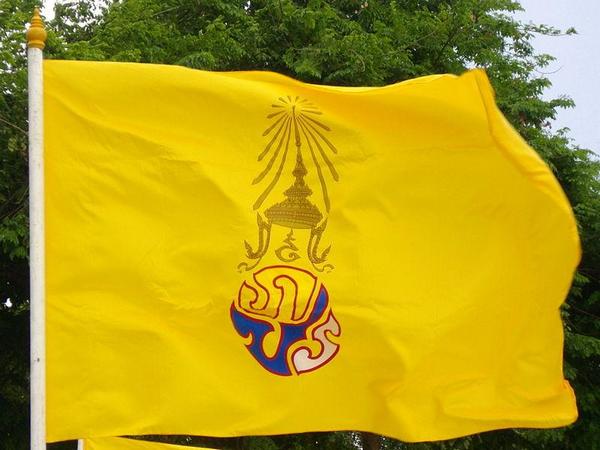
Although the chance that even the slightest problem will arise is extremely small. Thais treat foreigners in colorful clothes with restraint, they say “they don’t know what it means, so there’s nothing to blame.”
How to dress in Thailand?
And yet, what color should you choose to avoid misunderstandings, have a politically correct look and generally please the Thais? Many people probably won't like the answer, but it's...pink! In 2007, the king himself appeared in public wearing a pink blazer and a pink T-shirt - they say, on the advice of astrologers. In a matter of days, the fashion for pink swept across Thailand, and every third item of clothing released in Thailand was painted in this color. We know that pink is a difficult color to combine, and for most men it is completely unacceptable, but in Thailand they believe the opposite.
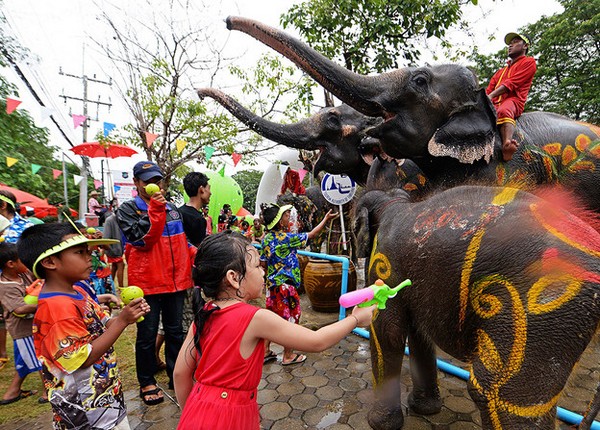
In general, you are going to Thailand to relax, and not to win the favor of the locals - you can dress as you like, they will treat you with understanding. But we would not recommend black, not only because it is considered “unlucky,” but also because in the Thai heat it is not the best choice. You can, of course, delve into Thai traditions and change your wardrobe every day, in accordance with Buddhist traditions - it’s fun, and you’ll get inspired by the flavor. All in your hands!
Flowers accompany the people of Thailand throughout their lives, from birth to death. They can be seen at weddings and funerals, in the forest and front garden, on a store window and on the altar of a temple; garlands are woven from flowers and used to decorate national cuisine...
For northerners Thailand with its sea of flowers is a most vibrant sight. This small tropical Asian country with a diverse climate is famous for its unique flora. There are more than 27,000 species of flowers here! And they are all charming in their own way and unique in beauty and aroma.
Even the local silk artificial flowers are a real work of art and a wonderful souvenir, for which many tourists go to a special market in the town of Mae Hong Son, not far from Pattaya. What can we say about living specimens!
Here you can see how the pineapple blooms its spherical flowers of various shades. You can admire the pink and yellow flowering trees cassia: the spectacle is no less fascinating than the sakura season in Japan. You can buy a beautiful armful of exotic flowers from any street vendor. You can make sure that the air freshener in local cars and buses is not pieces of cardboard, but fresh flower garlands. You can find out that the queen's flower in the country is considered to be snow-white jasmine, which is customary to give to all women in Thailand on Mother's Day, August 12. You can find out what a banana flower looks like or enjoy the aroma of the most delicate plumeria flowers, on the basis of which the famous Frangipani perfume was created. You can familiarize yourself with interesting history origin of the name of the red flower Ka-la, which received its name in honor of... the Russian Emperor Nicholas I!
Orchids and lotuses
There are countless flowers in Thailand, but the first place in beauty and significance for Thais is undoubtedly occupied by lotuses and orchids.
Lotus flower is one of the national symbols Thailand and a sacred plant for almost any resident of Asia. He is personified with Buddha, the Sun, the Universe, the meaning of life, and is considered the embodiment of purity, wisdom and perfection. A lotus bud makes its way from the muddy mud through the water until it blooms magnificently on its surface. large flower, which is impossible not to admire. Each such flower lives for only a couple of days, closing at night, and then it is replaced by neighboring buds.
It is the lotus that believers present as a gift to deities during religious ceremonies in Buddhist temples. It is also used in the preparation of incense - the aroma of lotus relieves tension and, according to legend, protects against the evil eye. Lotus seeds are added to baked goods in Thailand, and flowers and stems are added to soup. A decoction of lotus rhizomes has healing properties.
By the way, it is believed that the traditional Thai greeting - wai (palms folded in front of the chest) symbolizes the lotus bud.
There are more than a thousand species of orchids in Thailand! She is called the queen of flowers and is grown on numerous farms, where more and more new varieties are bred and from where these magnificent flowers are sold to all countries of the world. However, you can also see wild orchids (smaller and brighter) in almost any corner of the country - from the mountains to the jungle. For Thais, this flower is one of the most revered and beloved. They decorate suits, hairstyles, houses, restaurants, offices. Tourists, by the way, love to take these fragile flowers home as souvenirs - the export of live orchids from the country is not prohibited.
You can admire the huge collection of orchids in tropical garden "Nong Nooch": there these stunning flowers are presented in all the diversity and splendor of shapes and shades.
Flower Festival
The apogee of admiration for the local flora is the traditional three-day Flower Festival in the northern provincial town Chiang Mai, which is held annually in February, when the flowering time begins.
The word “Chiang Mai” itself translates as “sea of flowers”, and these days the city fully lives up to its name. The celebration begins early in the morning with an opening ceremony and a parade throughout the city, starting from Charoen Muang Road East. Along the streets, originally decorated with all kinds of flowers, accompanied by musicians, lines of cars are slowly moving, skillfully entwined with flower garlands and single flowers and fruits, making up complex mosaic compositions. During its movement, the parade constantly stops to give you the opportunity to see all the beauty and take great photos.
In addition to the parade, during the festival there are dance shows, fairs, exhibitions and competitions of flower decorators, and various performances. And the action ends in a truly enchanting way - with a beauty contest and the selection of the Queen of Flowers. Thai girls prepare for this event for a long time, embroidering exotic national dresses and thinking about what flowers to decorate themselves on such a significant day.
Flowers and perfume
It's interesting that the flowers Thailand respected not only by local residents and tourists, but also by local... spirits!
It is customary to present flowers to spirits and ancestors much more often than to living girls. In any temple you will certainly see skillfully woven garlands and entire panels of fresh flowers, and before entering you will be offered to buy at least one lotus flower or a branch of jasmine to appease the deities. Mystical entities in this country have considerable influence, so if you want good luck in business or love, do not skimp and buy a flower.
Many spirits in this country even have their own real estate! If you are visiting a Thai, be sure to pay attention to the tiny separate house on a pillar, abundantly decorated with a variety of fresh tropical flowers. Every morning, conscientious Thais renew the flower offering.
If you want to enjoy the flowers of Thailand to the fullest, be sure to visit at night Bangkok largest wholesale flower market Pak Khlong Talat. You are unlikely to find such a variety of color and aroma anywhere else. Thousands exotic plants, bouquets, flower decorations... But be sure to remember one small detail: smelling flowers in this market... is prohibited! After all, most locals buy flowers here specifically for spirits or deities, and they may be offended by such disrespectful treatment of “their flowers” and will give you a runny nose or something worse!
